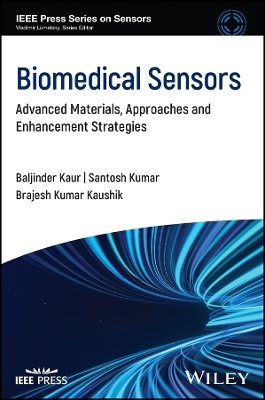
Biosensors
Wiley-IEEE Press (Verlag)
978-1-394-26820-7 (ISBN)
Biosensors summarizes cutting-edge technologies in biosensing, including gene editing (known as Clustered Regularly Interspaced Short Palindromic Repeat or CRISPR), quorum sensing utilizing inter and intra cell signals, two-dimensional (2D) materials and aptamer-mediated sensor designs, and more, with additional coverage of the latest materials, strategies, and advancements made in the field.
Chapters are categorized on the basis of various bio-recognition elements that include aptamer, nucleic acid, enzymes, antibodies, bacteriophages, peptides, and molecular imprinted polymers. Plasmonic, surface-enhanced Raman scattering, colorimetric, fluorescence, electrochemical, magneto and piezo-electric biosensor sensing techniques are also considered. The roles of various nanomaterials, advancement in synthesis, signal enhancement strategies, and new trends for biomedical applications are also described. Current challenges, limitations, and future prospects to developing biosensors for point-of-care and clinical applications are also discussed.
Written by three highly qualified authors, Biosensors includes information on:
Diverse bio-receptors include nucleic acids, aptamers, enzymes, antibodies, bacteriophages, molecularly imprinted polymers, whole-cell, and techniques of immobilization
Different transduction principles using bio-receptors (e.g., optical, electrochemical, piezo-electrical, and SERS) to detect microorganism, toxins, and diseases
Nanomaterials synthesis, their role in biosensing, pros and cons of carbon, polymer, metals, metal oxides, and quantum dots-based nanomaterials in medical biosensing applications
Biosensors is a comprehensive and complete resource on the subject for researchers and professionals in physics, chemistry, and biomedical science, research communities working in the fields of plasmonics, optics, biosensors, and nano-photonics, and students in related programs of study.
BALJINDER KAUR, PhD, is an Assistant Professor in the Department of Physics at the Madhav Institute of Technology & Science, Gwalior, India. SANTOSH KUMAR, PhD, is a Full Professor in the Department of Electronics and Communication Engineering at the Koneru Lakshmaiah Education Foundation Deemed to be University, Vaddeswaram, Guntur, India. BRAJESH KUMAR KAUSHIK, PhD, is a Full Professor in the Department of Electronics and Communication Engineering at the Indian Institute of Technology, Roorkee, India.
About the Authors ix
Preface xiii
Acknowledgments xvii
List of Abbreviations xix
About the Companion Website xxi
1 Fundamentals of Biomedical Sensors 1
1.1 Introduction 1
1.2 Classification of Biosensors 5
1.3 Elements of Biosensors 5
1.4 Bio-recognition Elements 5
1.4.1 Nucleic Acids 5
1.4.2 Aptamers 7
1.4.3 Enzymes 7
1.4.4 Antibodies 7
1.4.5 Bacteriophages 9
1.4.6 MIPs 10
1.4.7 Biosensors Based on Whole Cells 12
1.5 Sensing Techniques 14
1.5.1 ECL Biosensors 14
1.5.2 Optical Biosensors 15
1.5.2.1 Plasmonic Biosensors 15
1.5.2.2 Interferometric Sensors 18
1.5.2.3 Colorimetric Sensors 19
1.5.2.4 SERS-Based Biosensors 21
1.5.2.5 Fluorescence-Based Biosensors 23
1.5.2.6 Photonic Crystal-Fiber–Based Biosensors 24
1.5.3 Mass Biosensors 25
References 27
2 Immobilization Techniques for Bioreceptors 39
2.1 Introduction 39
2.2 Requirements of Immobilization 41
2.3 Immobilization Methods 42
2.3.1 Adsorption Immobilization or Electrostatic Interaction Method 42
2.3.2 Entrapment 43
2.3.3 Membrane Encapsulation 43
2.3.4 Covalent Immobilization 45
2.4 Materials Used in Different Immobilization Techniques and Supports 47
2.5 Future Prospects and Possibilities in Immobilization Technology 50
2.6 Summary 53
References 55
3 Nucleic Acid–Based Biosensors 63
3.1 Introduction 63
3.2 ECL Biosensor Designs 64
3.3 Nucleic Acid–Based Colorimetric Biosensors 67
3.4 Nucleic Acid–Based Fluorescent Biosensor 70
3.5 Nucleic Acid–Based Plasmonic Biosensor 71
3.6 SERS-Based Nucleic Acid Biosensors 76
3.7 Interferometric NA Biosensors 78
3.8 Conclusions and Future Prospects 81
References 81
4 Antibody-Based Biosensors 91
4.1 Polyclonal Antibody and Monoclonal Antibody 91
4.2 Cardiovascular Biomarker, Autoimmune Disorder, and Cholesterol Biomarker 94
4.2.1 Cancer Detection 94
4.2.2 Tuberculosis Detection 98
4.2.3 Cardiovascular Disease 104
4.2.4 Autoimmune Disease 105
4.2.5 Detection of Stress Biomarkers 105
4.2.6 Cholesterol Disease 107
4.2.7 Glucose Measurement 110
4.2.8 Microbe Detection: Viruses, Bacteria, Archaea, Fungi, and Protists 112
4.2.9 Toxins Detection 112
4.3 Conclusions and Future Directions 118
References 118
5 Aptamer-Based Biosensors 139
5.1 Introduction 139
5.2 Selection of Aptamers and Design Strategies 142
5.2.1 Modified Bases 143
5.2.2 Structural Modeling 143
5.2.3 Cell-SELEX 145
5.2.4 Counter-SELEX 145
5.2.5 High-throughput Sequencing 147
5.2.6 In Silico SELEX 147
5.2.7 Structure-Switching Signaling-Based Aptamers 148
5.2.8 Folding Aptamer-Based Biosensors 150
5.2.9 Split Aptamers 153
5.3 Sepsis, Pathogens, and Biomarkers to Detect Disease and Pollutants 155
5.4 Small Biomolecules 158
5.5 Summary 163
References 163
6 Bacteriophage-Based Biosensors 177
6.1 Introduction 177
6.1.1 Reporter Bacteriophages 180
6.1.2 Stained Phages 180
6.1.3 Lytic Phages 181
6.1.4 Capturing Phages 181
6.1.5 Phage Receptor-Binding Proteins 181
6.2 Design of Bacteriophage-Based Biosensor 182
6.3 Future Prospects 195
6.4 Summary 196
References 196
7 Peptide-Based Biosensors 203
7.1 Introduction 203
7.2 Synthesis Methods 204
7.2.1 Design of ECL Biosensors 205
7.2.2 Design of Plasmonics Biosensors 213
7.2.3 Design of Colorimetric Biosensors 218
7.2.4 Design of Fluorescence Biosensors 219
7.2.5 Design of Interferometric Biosensors 224
7.2.6 Design of SERS-Based Biosensors 225
7.3 Summary 228
References 229
8 Synthetic BREs and Smart Nanomaterial-Based Biosensors 239
8.1 MIPs as Bioreceptors and Their Applications 239
8.2 Nanomaterials-Based Sensors 242
8.2.1 Metals and Metal-Oxide-Based Nanomaterials 242
8.2.2 Carbon-Based Nanomaterials 244
8.2.3 Magnetic, 2D Nanomaterials, Quantum Dots, and Polymer-Based Nanomaterials 250
8.2.4 Nanomaterials for Wearable Biosensors 254
8.3 Summary 261
References 262
9 Advancement in Optical Biosensors to Detect Malignant Tumors 281
9.1 Introduction 281
9.2 Cancer Biomarkers 282
9.3 Types of Optical Biosensors 284
9.3.1 SPR and LSPR Sensors 285
9.3.2 Colorimetric Sensors 289
9.3.3 Fluorescence Sensors 289
9.3.4 Interferometric Sensors 292
9.3.5 SERS Sensors 292
9.3.6 Metall-Insulatorl-Metal Waveguidel-Resonator-Based Optical Sensors 294
9.4 Challenges and Future Prospects 296
9.5 Summary 298
References 299
Index 307
| Erscheinungsdatum | 28.11.2024 |
|---|---|
| Reihe/Serie | IEEE Press Series on Sensors |
| Sprache | englisch |
| Gewicht | 662 g |
| Themenwelt | Medizin / Pharmazie ► Physiotherapie / Ergotherapie ► Orthopädie |
| Technik ► Elektrotechnik / Energietechnik | |
| Technik ► Medizintechnik | |
| Technik ► Umwelttechnik / Biotechnologie | |
| ISBN-10 | 1-394-26820-3 / 1394268203 |
| ISBN-13 | 978-1-394-26820-7 / 9781394268207 |
| Zustand | Neuware |
| Informationen gemäß Produktsicherheitsverordnung (GPSR) | |
| Haben Sie eine Frage zum Produkt? |
aus dem Bereich


